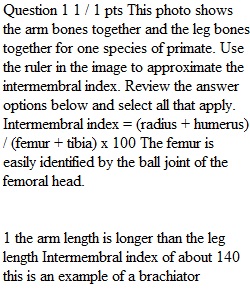


Q Question 1 1 / 1 pts This photo shows the arm bones together and the leg bones together for one species of primate. Use the ruler in the image to approximate the intermembral index. Review the answer options below and select all that apply. Intermembral index = (radius + humerus) / (femur + tibia) x 100 The femur is easily identified by the ball joint of the femoral head. Question 2 1 / 1 pts This photo shows the arm bones together and the leg bones together for one species of primate. Use the ruler in the image to approximate the intermembral index. Review the answer options below and select all that apply. Intermembral index = (radius + humerus) / (femur + tibia) x 100 The femur is easily identified by the ball joint of the femoral head. Question 3 0.5 / 0.5 pts This photo shows the right os coxae and part of the sacrum of a chimpanzee pelvis. Use the ruler to estimate the iliac blade width and height and calculate the ilium index. Select all correct answers from the options below. Ilium Index = ( Iliac blade width / iliac blade height ) x 100 Question 4 0.5 / 0.5 pts This photo shows the right os coxae and part of the sacrum of a human pelvis. Use the ruler to estimate the iliac blade width and height and calculate the ilium index. Select all correct answers from the options below. The ruler for the blade height is at an angle for a reason :) Ilium Index = ( Iliac blade width / iliac blade height ) x 100
View Related Questions